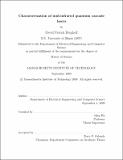| dc.contributor.advisor | Qing Hu. | en_US |
| dc.contributor.author | Burghoff, David Patrick | en_US |
| dc.contributor.other | Massachusetts Institute of Technology. Dept. of Electrical Engineering and Computer Science. | en_US |
| dc.date.accessioned | 2010-05-27T20:20:00Z | |
| dc.date.available | 2010-05-27T20:20:00Z | |
| dc.date.copyright | 2009 | en_US |
| dc.date.issued | 2009 | en_US |
| dc.identifier.uri | http://hdl.handle.net/1721.1/55343 | |
| dc.description | Thesis (S.M.)--Massachusetts Institute of Technology, Dept. of Electrical Engineering and Computer Science, 2009. | en_US |
| dc.description | This electronic version was submitted by the student author. The certified thesis is available in the Institute Archives and Special Collections. | en_US |
| dc.description | Cataloged from student-submitted PDF version of thesis. | en_US |
| dc.description | Includes bibliographical references (p. 97-99). | en_US |
| dc.description.abstract | Quantum cascade lasers provide some of the highest output powers available for light in the mid-infrared range (from 3 to 8 m). As many of their applications require portability, designs that have a high wall-plug efficiency are essential, and were designed and grown by others to achieve this goal. However, because a large fraction of these devices did not operate at all, very few of the standard laser measurements could be performed to determine their properties. Therefore, measurements needed to be performed that could non-destructively probe the behavior of QCLs while still providing useful information. This thesis explores these types of measurements, all of which fall into the category of device spectroscopy. Through polarization-dependent transmission and photovoltaic spectroscopy, a large portion of the quantum mechanical bandstructure could be determined, along with many of the parameters characterizing crystal growth quality. In addition, high-resolution transmission spectroscopy was used to find the properties of the QCL waveguide. In order to find the correspondence between theory and experiment, bandstructure simulations were performed using a three-band p model, and two-dimensional electromagnetic simulations were performed to describe the laser's optical properties. These simulations were found to be in relatively good agreement with the device measurements, and any discrepancies were found to be consistent with problems in the growth and fabrication. | en_US |
| dc.description.statementofresponsibility | by David Patrick Burghoff. | en_US |
| dc.format.extent | 99 p. | en_US |
| dc.language.iso | eng | en_US |
| dc.publisher | Massachusetts Institute of Technology | en_US |
| dc.rights | M.I.T. theses are protected by
copyright. They may be viewed from this source for any purpose, but
reproduction or distribution in any format is prohibited without written
permission. See provided URL for inquiries about permission. | en_US |
| dc.rights.uri | http://dspace.mit.edu/handle/1721.1/7582 | en_US |
| dc.subject | Electrical Engineering and Computer Science. | en_US |
| dc.title | Characterization of mid-infrared quantum cascade lasers | en_US |
| dc.type | Thesis | en_US |
| dc.description.degree | S.M. | en_US |
| dc.contributor.department | Massachusetts Institute of Technology. Department of Electrical Engineering and Computer Science | |
| dc.identifier.oclc | 599812252 | en_US |
